
views
Sprouting the Tomato Plant

Fill your seed starter cell with moist potting soil. When the container is full, gently pack down the soil with your fingers just enough to remove any air bubbles that may be trapped. Apply a small sprinkling of water to the soil, as this will help the seed set.

Make two holes in the soil. Use the end of a pencil or your finger to poke two shallow holes in the soil in the seed cell. Each hole will be for two or three tomato seeds. The holes should be about a quarter-inch (6 mm) deep. Planting two seeds will increase your chances of success, because there's always the possibility that one won’t germinate.

Cover the seeds with a small amount of soil. When there's two or three seeds in each hole, cover the holes with a quarter-inch (6 mm) of soil. Gently press down on the soil again with your fingers to pack it down and ensure the seed is in complete contact with the soil. However, do not overpack the soil. This will encourage germination. Smaller tomato varieties, such as cherry or grape, are better for upside-down growing. Tomatoes are categorized as indeterminate and determinate. Indeterminate tomatoes are better for upside-down planters because they're more flexible and won’t produce all their fruit at once, which can weigh down the planter.

Add a few drops of water. The goal is to moisten the new soil surrounding the seeds. You can use an eyedropper to apply a small amount of water, or wet your fingers and let a few drops of water drip off. Don’t add too much water, as the soil was already pre-moistened before planting. Keep the soil moist, but not soggy, as the sprouts grow. When the top of the soil becomes dry, add more water.

Provide the seeds with plenty of light and warmth as the sprouts grow. Place the seed cell in a warm and sunny window. The seeds should be kept at a minimum of 70 F (21 C) as they germinate. The seeds and sprouts will also require at least six hours of direct sunlight every day. If you do not have enough light in your home, then use artificial lighting.

Remove the smaller plant. When the tomato plants sprout and grow their first set of leaves, look at the two sprouts to identify the larger and healthier sprout. Remove the weaker sprout by trimming it at the soil level. You can either clip it off with scissors, or pinch it off with your fingers. Removing the weaker sprout will ensure the healthier plant doesn’t have to compete for nutrients and light.
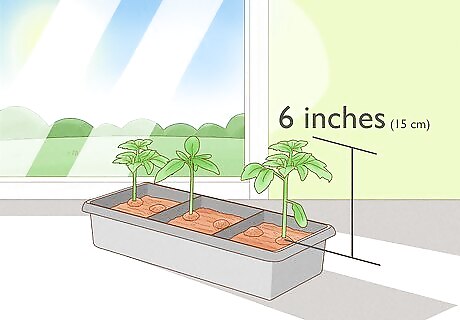
Wait for the plant to reach a height of 6 inches. Continue watering the tomato, keeping it warm, and providing it with plenty of sunlight as it grows. The plant should be about 6 inches (15 cm) before you transplant it to the upside-down planter. This will ensure the plant and the root system are established enough to take root in the new location. Don’t let the tomato grow any bigger, otherwise the roots may get damaged when it’s transplanted.
Making the Upside-Down Planter
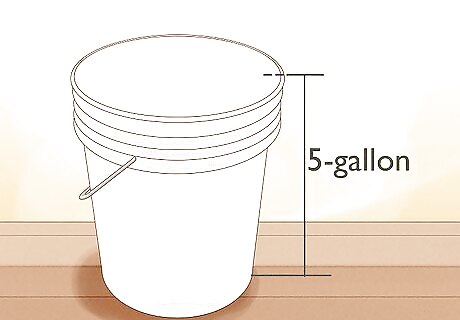
Choose a planter container. Most homemade upside-down planters are made from 5-gallon (19-L) plastic buckets. You can also use a large planter, metal buckets, or any other large container that you can cut or drill a hole into.
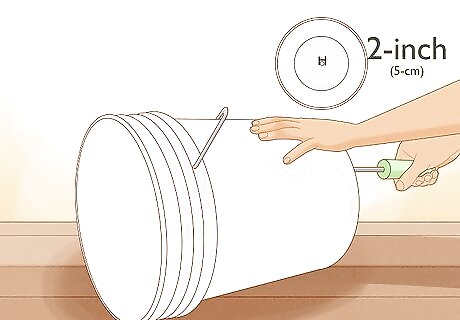
Cut a hole in the bottom. Turn the bucket over so the bottom is facing up. Use a marker and the rim of a glass to trace a 2-inch (5-cm) circle in the center of the bucket. You can also free-hand the circle if you don’t have something to trace. Then, use a sharp utility knife to carefully cut out the hole marked by the marker.
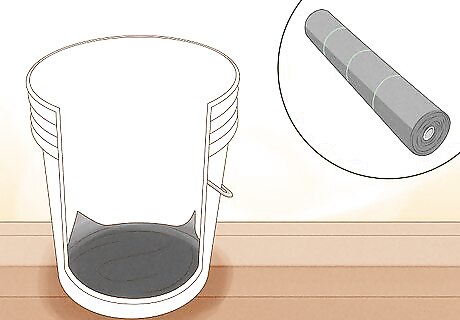
Cover the bottom of the bucket with landscape material. Turn the bucket over so it’s right-side up. Cut out a piece of landscape material that’s the same size as the bottom of the bucket. Place the material in the bottom of the bucket. This will keep the tomato plant and soil in place. Instead of landscaping material, you can also cover the bottom of the bucket with shredded newspaper, window screen, or disposable coffee filters.
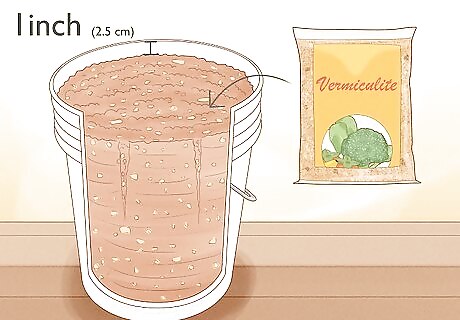
Fill the bucket with soil. Fill the bucket three-quarters of the way with potting soil, and the rest of the way with vermiculite, leaving an inch (2.5 cm) of headroom at the top of the bucket. Use a stick or your hands to mix the soil and vermiculite together. The potting soil will provide a rich and nutrient-dense medium for the tomato, and the vermiculite will help the soil to retain moisture.
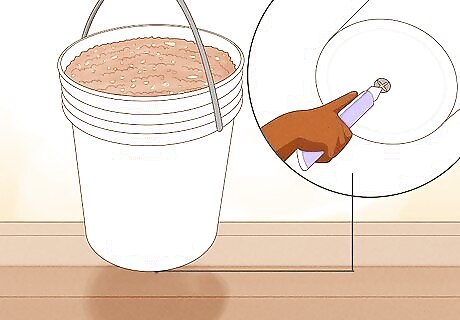
Cut a hole in the landscape material. Hang the bucket from a hook or holder so you can access the bottom. Use a sharp utility knife or scissors to cut an X in the landscape material covering the hole in the bucket. This will allow you to insert the root ball into the bucket, but will prevent all the soil from falling out.
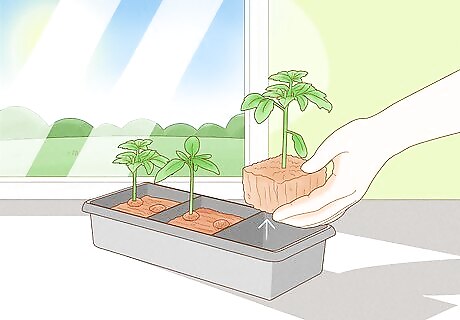
Remove the tomato plant from the starter cell. Gently squeeze the seed starter cell to break up the soil and loosen the tomato root ball. Place your hand over the base of the plant and turn the starter upside down. As the plant slides out, gently but firmly hold the stem and roots and pull out the plant.
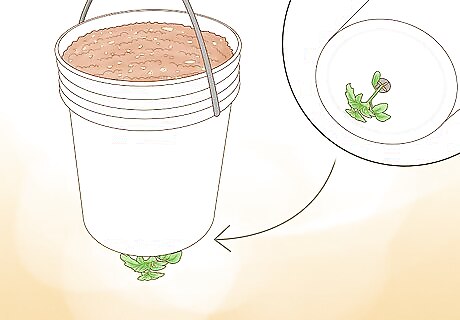
Insert the tomato plant roots-first into the hole. Use your fingers to press open the flaps of the landscaping material in the bottom of the upside-down planter. Gently insert the root ball into the hole in the bucket to firmly plant the tomato in the soil. When the root ball is in place, close the flaps of the landscape material back around the base of the plant. As you plant the tomato into the bucket, be careful not to damage the roots or the stem.
Caring for the Tomato Plant
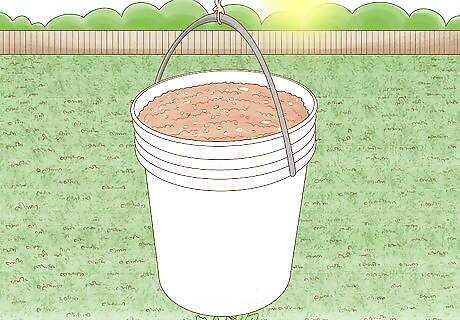
Hang the planter in a sunny location. Tomatoes require at least six to eight hours of sunlight each day. Choose a bright location for the planter where it will receive full and direct sun. You can hang the planter from a sturdy hook inserted into a beam or post, from a garden hook fastened to a fence, or from a plant hanger.
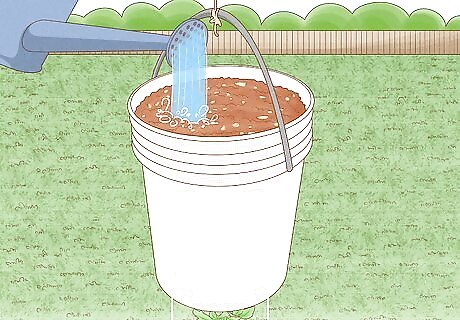
Water the tomato plant as the soil dries. Tomatoes like moist soil that isn't soggy. When the top of the soil starts to dry out, water the plant. Tomatoes grown upside down tend to need more water, and you may have to water daily to keep the soil moist. Depending on how high up the top of the bucket is, you may need a chair or step ladder to check the soil and water the plant. If water is dripping through the hole in the bottom of the bucket, you can catch the excess with a pan or drip tray. You can also place another plant underneath the tomato to catch the water.
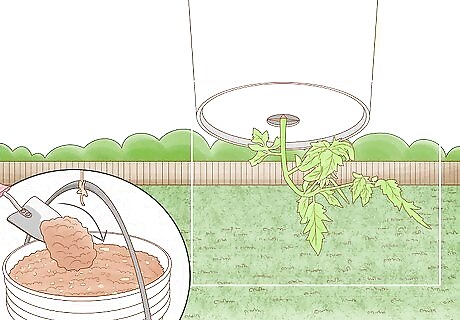
Top up the soil level as necessary. Because the soil at the top of the bucket is exposed, you may need to top it up now and again. When you water, check to see if there has been any soil loss. If there has, top the bucket up to within an inch (2.5 cm) of the top with extra potting soil or aged compost.
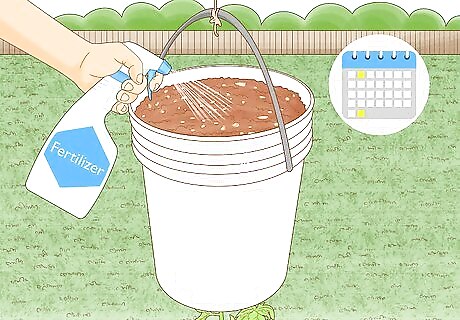
Add a fertilizer every two or three weeks to accelerate growth. Your tomatoes may not need fertilizer, especially if you used a nutrient-rich potting soil. To promote growth, however, feed the tomatoes with a mild plant food, such as a fish-based fertilizer or diluted compost tea. Mix the liquid fertilizer with water and water the plant to administer the fertilizer.




















Comments
0 comment